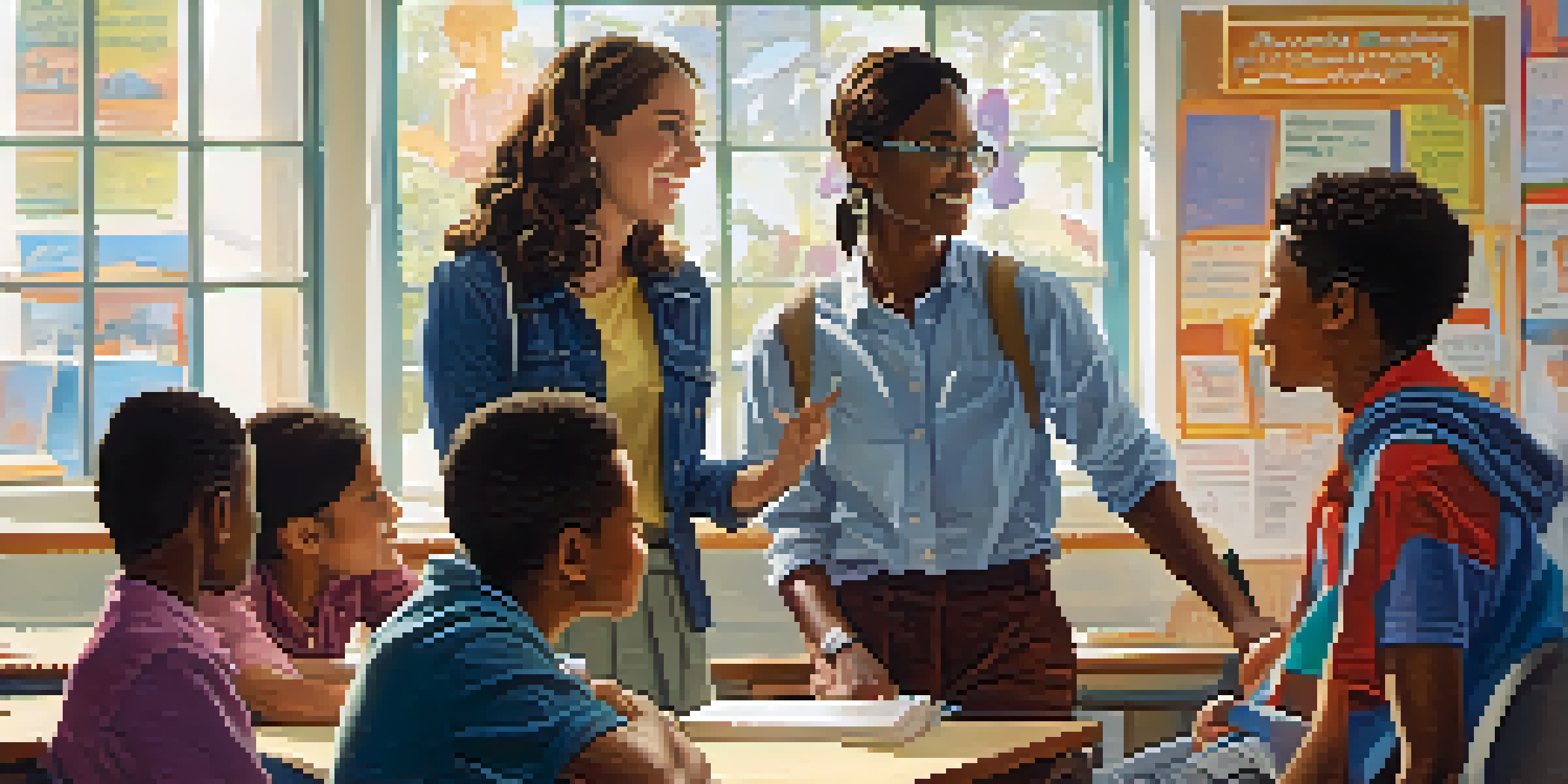The Role of Nonverbal Communication in Social Learning

Understanding Nonverbal Communication: The Basics
Nonverbal communication encompasses all the ways we convey messages without words. This includes facial expressions, gestures, posture, and even eye contact. For instance, a smile can indicate friendliness, while crossed arms might suggest defensiveness. By grasping these cues, individuals can better interpret the emotions and intentions of others, making interactions smoother.
The most important thing in communication is hearing what isn't said.
In social learning contexts, these nonverbal signals play a crucial role in understanding the dynamics between individuals. Imagine a classroom where a teacher uses hand gestures to emphasize points; students can absorb information more effectively through these visual cues. Thus, nonverbal communication acts as a bridge, connecting verbal messages with emotional undertones.
Furthermore, nonverbal cues can vary significantly across cultures, adding another layer of complexity. What might be seen as a positive gesture in one culture could be offensive in another. Therefore, being aware of these differences is essential for effective social learning in diverse environments.
The Importance of Body Language in Social Interactions
Body language serves as a powerful tool in conveying feelings and attitudes. For example, leaning in during a conversation can demonstrate interest and engagement, while turning away may signal disinterest. This form of communication is often subconscious, meaning people may not even realize they are sending these signals.

In social learning, body language can enhance the understanding of concepts being taught. Consider a group discussion where participants use open body language; this creates a welcoming atmosphere, encouraging all to share their thoughts. When learners observe positive body language, they are more likely to participate actively and confidently.
Nonverbal Cues Enhance Understanding
Recognizing nonverbal signals like gestures and facial expressions improves our ability to interpret emotions and intentions in social interactions.
Moreover, body language can reinforce verbal communication. When a speaker’s words align with their physical cues, the message becomes more credible. This synergy helps create a more convincing narrative, fostering trust and connection among participants in social learning environments.
Facial Expressions: A Window to Emotions
Facial expressions are perhaps the most immediate form of nonverbal communication. A simple frown or smile can convey a wealth of information in an instant. For example, if a teacher shows excitement through their expression when discussing a topic, students are likely to feel the same enthusiasm.
You can’t not communicate. Every behavior is a form of communication.
In social learning, recognizing and interpreting facial expressions can significantly enhance group dynamics. For instance, a group project can benefit from members who can read each other's emotions, leading to better collaboration and understanding. This empathetic approach fosters a supportive learning environment.
Additionally, being aware of one's facial expressions can improve personal interactions. If a learner is aware that they often look confused during discussions, they can take steps to clarify their understanding. This self-awareness contributes to more effective communication and learning outcomes.
The Role of Eye Contact in Communication
Eye contact is a crucial aspect of nonverbal communication that can significantly affect interactions. It helps establish trust and engagement, indicating that someone is attentive and interested. However, the amount and nature of eye contact can vary greatly across cultures, making it essential to understand these differences in social learning contexts.
In educational settings, eye contact can encourage participation and foster a sense of community. When a teacher makes eye contact with students, it creates a connection that invites dialogue and feedback. This interaction not only enhances the learning experience but also builds students' confidence in expressing their ideas.
Body Language Builds Engagement
Positive body language fosters a welcoming environment, encouraging active participation and collaboration in social learning settings.
Moreover, the ability to maintain appropriate eye contact can influence perceptions of credibility and authority. Individuals who can effectively use eye contact often come across as more persuasive and knowledgeable. This skill can be particularly beneficial in social learning environments, where clear and effective communication is key.
Gestures: Enhancing Verbal Communication
Gestures are another vital component of nonverbal communication that can enhance verbal messages. They can help illustrate points, making abstract concepts more concrete. For instance, a teacher might use hand movements to demonstrate the size or shape of an object, aiding visual learners in grasping the information.
In social learning, gestures can lead to more dynamic interactions. When participants use gestures, they often become more engaged and invested in the discussion. This not only helps in retaining information but also encourages others to contribute, fostering a collaborative learning atmosphere.
However, it's essential to be aware of cultural differences regarding gestures. A gesture that is positive in one culture might be misunderstood in another. Therefore, being mindful of these nuances can help facilitate smoother communication and understanding in diverse social learning environments.
The Impact of Proxemics on Social Learning
Proxemics refers to the use of personal space in communication. The distance we maintain during interactions can convey levels of intimacy or authority. For example, standing too close may feel intrusive, while too much distance can create a sense of detachment. Understanding these spatial dynamics is crucial in social learning settings.
In a classroom or group setting, appropriate use of space can foster comfort and openness. When learners feel they have a suitable amount of personal space, they are more likely to engage and share their ideas. This comfort can lead to richer discussions and more effective collaborative efforts.
Cultural Awareness is Key
Understanding cultural differences in nonverbal communication is essential for effective interactions and inclusive learning experiences.
Additionally, leaders or educators can leverage proxemics to establish authority and respect. By maintaining a confident yet approachable distance, they can create an environment where participants feel valued and heard. This balance is essential for promoting positive social learning experiences.
The Interplay Between Nonverbal and Verbal Communication
The relationship between nonverbal and verbal communication is intricate and essential for effective interaction. Nonverbal cues often complement and enhance spoken words, creating a more complete message. For instance, saying 'I'm excited' while smiling reinforces the emotion behind the words.
In social learning environments, this interplay becomes even more significant. When learners can observe and interpret nonverbal signals alongside verbal communication, they gain a deeper understanding of the material. This combination leads to a more holistic learning experience, where both content and context are appreciated.

Moreover, being aware of one’s nonverbal signals can help prevent misunderstandings. When individuals align their verbal and nonverbal communication, they create clarity and reduce the risk of misinterpretation. This alignment is key in fostering effective communication and collaboration in social learning settings.
Enhancing Social Learning Through Nonverbal Awareness
Becoming aware of nonverbal communication can significantly enhance social learning experiences. By paying attention to gestures, facial expressions, and body language, individuals can better understand and connect with others. This awareness allows for more effective interactions, leading to richer discussions and collaborations.
Moreover, fostering a culture of nonverbal awareness in educational settings can empower learners. When students are encouraged to observe and interpret nonverbal cues, they develop essential social skills that extend beyond the classroom. This skill set is invaluable in both personal and professional contexts.
Lastly, creating environments that prioritize nonverbal communication can lead to stronger relationships and improved learning outcomes. By valuing these cues, educators and participants alike can cultivate a more inclusive and engaging social learning atmosphere, ultimately enhancing the overall experience.